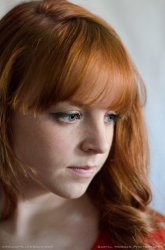DGMPhotography
Been spending a lot of time on here!
- Joined
- Mar 23, 2012
- Messages
- 3,160
- Reaction score
- 718
- Can others edit my Photos
- Photos OK to edit
Follow along with the video below to see how to install our site as a web app on your home screen.

Note: This feature currently requires accessing the site using the built-in Safari browser.
I was thinking the same thing. Her eyes are nice and crisp, which is good, but the hair along her forehead is out.Looks okay. Shame about the too-shallow DOF though.
Hey there,
So I would love some thoughts on my image here! Also wondering if you think I should clean up her hair a little bit in post, or leave it as is?

Very subtle change made by apaflo, and I like this way of thinking about a picture.
And yet, when looked at large, it still looks like the photographer botched a dead-simple shot by falling into the noob-trap of shooting wide-open from very close with a 50mm lens...it's like telling a beginning singer, "Okay, if you're going to sing off-key, here's how to disguise it...sing LOUDLY, and it'll sound better."
The noob-trap is shooting everything at wide-open aperture...you know...so the forehead is out of focus, one eye is in focus, one eye is out of focus...it's being "enthralled" by the lure of "f/1.8".
The realism is killed by the needless lack of focus. It serves no purpose, but just calls attention to the inexperience of the shooter. That's what a 50mm shot wide-open basically is...a noob-trap. You can point out ways to lessen the impact of blown focus and bad composition all you want. It's a great exercise for you,apparently.
Correcting faults and mistakes after the fact is the province of many of today's digital snappers. As the OP asked, "Should I have fixed these things?" My answer is , "You should have used more photographic skill when making the exposure, and done it right, in-camera." My answer is, "No, you should not have to "fix" mistakes, but rather, use the equipment as a skilled shooter would have and thus not MAKE the mistakes in the first place. Do not commit mistakes to film (or sensor)."
Sing in-key, not off-key. Spell properly, not haphazardly. Drive safely, not like a fool. Take a few extra seconds, and do it right, the first time.
I would say the DOF is far from "perfect".
for portraits, you would typically shoot with a shallow DOF to blur an otherwise distracting or busy background.
in this case, there is nothing in the background that benefits from OOF or bokeh. instead, what we get is half of the headshot in focus, with the face, head, and hair quickly falling out of focus. this is generally not as desirable in a portrait where the subject is turned to that angle.
on a side note. yes. photos are realism. especially portraits. this is her. this is what she really looks like (I assume)
I would say the DOF is far from "perfect".
for portraits, you would typically shoot with a shallow DOF to blur an otherwise distracting or busy background.
in this case, there is nothing in the background that benefits from OOF or bokeh. instead, what we get is half of the headshot in focus, with the face, head, and hair quickly falling out of focus. this is generally not as desirable in a portrait where the subject is turned to that angle.
Why do we want to blur a distracting background? And why would not the exact same reason be applied to something other than "background"? If the answer to the first question applies to something other than "background", then the exact same treatment applies.
There is no reason to necessarily avoid "the face, head, and hair quickly falling out of focus" if that produces an effect that is dramatically better than not.
Following these basic rules of thumb for beginners will prevent a photographer's style from ever developing past a beginning photographer's look! Follow them only until you can learn how to decide when to do better.
Here is a link that clearly demonstrates exactly how useful a narrow DOF can be for a portrait.
Nice portrait with narrow DOF.
Can we agree that the photographer who made that image didn't fall into any "noob-trap"? If so, note that it is virtually the same style as the image in this thread. One eye is in focus, the other not. Most if not all of the hair is blurred. DOF is very limited almost certainly by purposely using an f/1.4 aperture!
on a side note. yes. photos are realism. especially portraits. this is her. this is what she really looks like (I assume)
Fantasy!
It isn't her, and it is not really even what she looks like. It's just a photgraph, and is an illusion that reminds us of her.
Photographs are all illusions. Literally by definition. In particular, a portrait can never be reality. Reality is a living breathing human, an illusion is a photograph that makes you say, "That's Kathleen!" Except, it's a photograph, not Kathleen. (Ask the photograph how she feels today...)